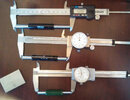mofosheee
Member
Suppose I take a case of fire formed brass from my AR. I bump the shoulder back 0.002" using a full length re-sizing die. Measuring that case in my comparator/ calipers, that case becomes my referrence and that
all future cases ran through that undisturbed re-sizing die will be close to the reference. Correct?
Moving on, I grab a handfull of range brass measure it to find most of it is oversize by 0.002" - 0.005" (ish). I run them through the sizing die and they all zero out. No problemo.
Some of the cases measure -0.002 or -0.003" (negitive) undersize to my reference brass before being run through the resizing die. When these cases were run through the die I'm thinking that they would not
be brought back to 0.000" affecting my headspace ........... but these cases zero'ed out.
The question is, am I correct to assume that the reforming (resizing) process also forces brass to conform/flow within the die whether the brass is smaller or larger (within limitations)
hope this makes sense.
Thanks again!
all future cases ran through that undisturbed re-sizing die will be close to the reference. Correct?
Moving on, I grab a handfull of range brass measure it to find most of it is oversize by 0.002" - 0.005" (ish). I run them through the sizing die and they all zero out. No problemo.
Some of the cases measure -0.002 or -0.003" (negitive) undersize to my reference brass before being run through the resizing die. When these cases were run through the die I'm thinking that they would not
be brought back to 0.000" affecting my headspace ........... but these cases zero'ed out.
The question is, am I correct to assume that the reforming (resizing) process also forces brass to conform/flow within the die whether the brass is smaller or larger (within limitations)
hope this makes sense.
Thanks again!


